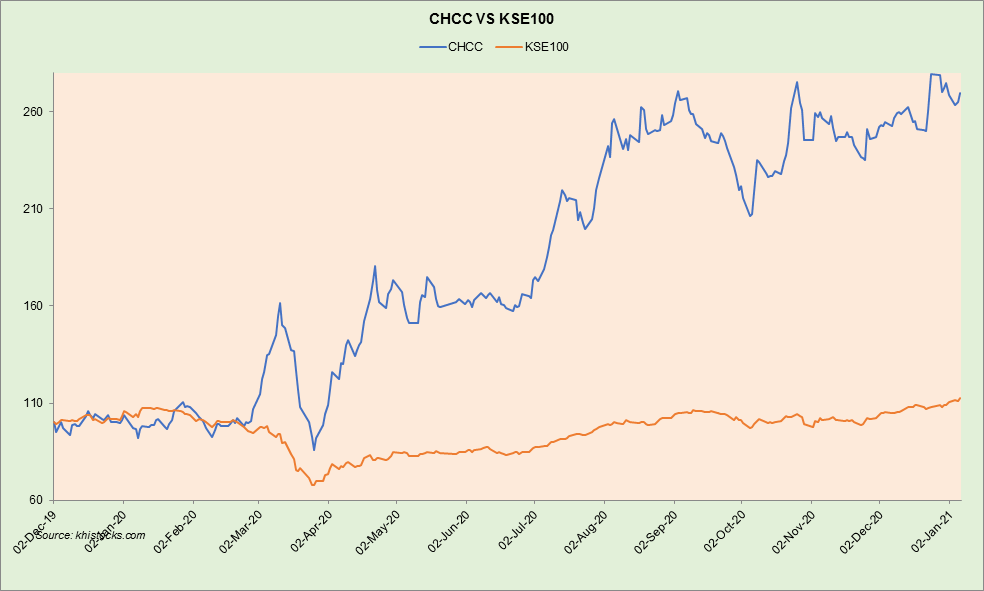Cherat Cement Company Limited
Cherat Cement Company Limited (PSX: CHCC) was set up in 1981 as a public company. it is part of the Ghulam Faruque Group (GFG) Company.
The company manufactures, markets, and sells clinker and cement. It sells under its brand name “Cherat”. Its plant is located in Khyber Pakhtunkhwa (KPK) province which makes it an ideal location due to the proximity to the Afghan border, given that Afghanistan is a major destination for Pakistan’s cement exports. In addition to this, the markets of Azad Kashmir, FATA and Punjab are also accessible.
Shareholding pattern
As of June 30, 2020, the associated companies, undertakings, and related parties have the largest number of shares, at 29 percent. Within this category, Faruque (Private) Limited is the major shareholder owning nearly 22 percent of the shares. Close to 30 percent shares are with the local general public, followed by 15 percent held under “others”. About 9 percent and 7 percent are held under mutual funds and banks, DFIs and NBFCs, respectively. The directors, CEO, their spouses, and minor children hold around 4 percent shares; the remaining 6 percent shares are with the rest of the shareholder categories.

Historical operational performance
The company has consistently seen rising topline albeit at varying rates, while profitability seems to have declined after FY16.

During FY17, Cherat Cement saw one of the highest sales growths as topline saw a 36 percent climb. This was due to a combination of factors: a rise in domestic demand by 8 percent during the year, and the company’s expansion that led to an increase in the production capacity to 2.4 million tons. The rise in demand was generated through PSDP spending by the government as well as private sector spending on housing and commercial projects. This is reflected in the increased domestic sales volumes- by nearly 64 percent. While higher cost of production kept gross margins low, the bottomline was sustained due to other income, allowing net margin to remain flat.

Cherat Cement witnessed the highest growth in sales revenue during FY18, at 49 percent. The overall cement industry in the country grew by close to 14 percent. Unlike the previous years where export sales had taken a backseat, in FY18 export sales volumes also picked, while domestic sales continued to grow volumetrically- this year registering almost 65 percent increase. Apart from better demand, this was also attributed to enhanced production capacity; benefit, from Line 2 that was set up in the second half of FY17, was fully realized for the whole year. However, owing to a high cost of production as a percentage of revenue, due to currency evaluation and high coal prices, gross margin dropped to almost 22 percent while net margin was lower due to higher finance expense.

The year FY19 began with general elections being held in the country. In order to stabilise the economy, the new government cut back PSDP budget, increased interest rates, the currency was devalued, and inflation was high. This adversely affected the business industry including the cement industry; the latter witnessed a minute 2 percent growth. This is also reflected in Cherat Cement’s topline growth at 10 percent- much lower than that seen in the last two years. Volumetrically, sales were lower than the previous year. This was due to fall in domestic sales, whereas export sales picked up; the latter largely comprised of sea exports. This indicates that the rise in revenue was due to an increase in selling price. However, this did not translate into profitability due to cost of production consuming almost 82 percent of revenue- a result of high fuel prices and currency devaluation. This was further exacerbated by finance expense; thus, net margin fell to 11 percent.

With the commissioning of the new line- Line 3 during the second half of FY19, the company’s total annual installed production capacity rose to 4.3 million tons for clinker and 4.5 million tons for cement. This is also reflected in the higher production for FY20. Total sales volumes rose by 35 percent; both domestic and export sales increased. Although this only translated into an almost 8 percent increase in sales revenue. The lower prices were due to higher supply in comparison to demand. Cost of production and finance expense remained undeterred, eventually leading the company to post a loss of near Rs 2 billion in FY20
Quarterly results and future outlook
There was a 16 percent rise in topline during 1QFY21 as demand bounced back after the lock down in the event of the outbreak of Covid-19 pandemic. Total sales volumes increased by 10 percent; nearly 28 percent increase in domestic sales while export sales reduced by 52 percent. This was due to increased traffic at the Afghan border after its opening post-shutdown. Cost of production also reduced significantly allowing for some profitability in 1QFY21 as compared to the loss in 1QFY20.

The government’s efforts to recover the economy with announcing a construction packages, reducing interest rates and focusing on housing will have a positive impact for the industry in the future. A peaceful political environment will also help to encourage sales to the country.
























Comments
Comments are closed.